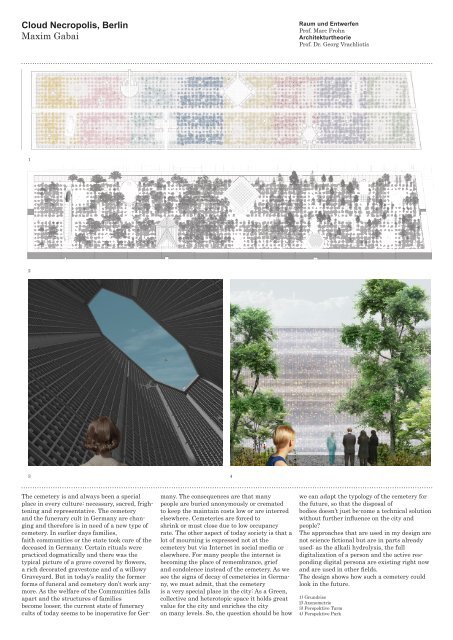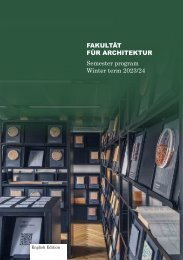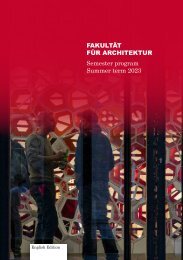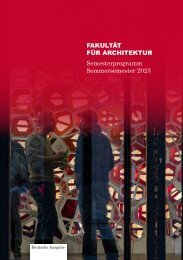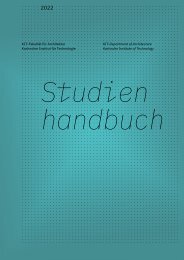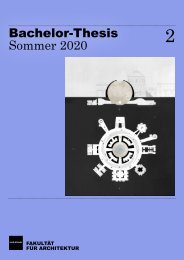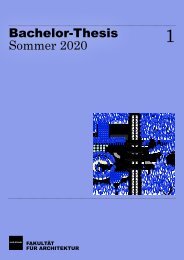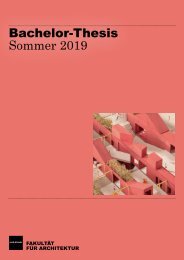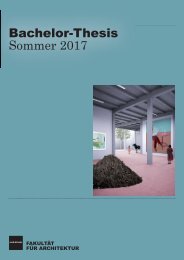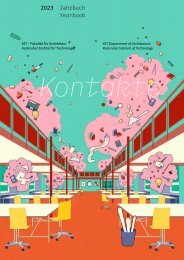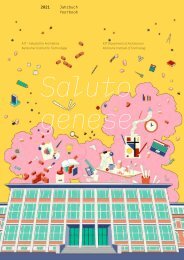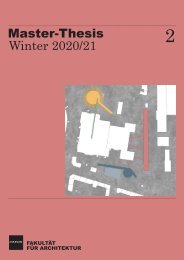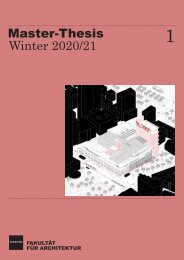KIT-Fakultät für Architektur – Master-Arbeiten Winter 2017/18
Dokumentation von Masterabschlussarbeiten des Wintersemesters 2017/18 an der Fakultät für Architektur am Karlsruher Institut für Technologie.
Dokumentation von Masterabschlussarbeiten des Wintersemesters 2017/18 an der Fakultät für Architektur am Karlsruher Institut für Technologie.
Sie wollen auch ein ePaper? Erhöhen Sie die Reichweite Ihrer Titel.
YUMPU macht aus Druck-PDFs automatisch weboptimierte ePaper, die Google liebt.
Cloud Necropolis, Berlin<br />
Maxim Gabai<br />
Raum und Entwerfen<br />
Prof. Marc Frohn<br />
<strong>Architektur</strong>theorie<br />
Prof. Dr. Georg Vrachliotis<br />
1<br />
2<br />
Cloud Necropolis Maxim Gabai 1680782<br />
<strong>Winter</strong>semester <strong>2017</strong>/<strong>18</strong><br />
Im Turm<br />
Fachgebiet Raumgestaltung Prof. Marc Frohn<br />
Fachgebiet <strong>Architektur</strong>theorie Prof. Georg Vrachliotis<br />
3 4<br />
Cloud Necropolis Maxim Gabai 1680782<br />
<strong>Winter</strong>semester <strong>2017</strong>/<strong>18</strong><br />
Blick auf Mauer<br />
Fachgebiet Raumgestaltung Prof. Marc Frohn<br />
Fachgebiet <strong>Architektur</strong>theorie Prof. Georg Vrachliotis<br />
The cemetery is and always been a special<br />
place in every culture: necessary, sacred, frightening<br />
and representative. The cemetery<br />
and the funerary cult in Germany are changing<br />
and therefore is in need of a new type of<br />
cemetery. In earlier days families,<br />
faith communities or the state took care of the<br />
deceased in Germany. Certain rituals were<br />
practiced dogmatically and there was the<br />
typical picture of a grave covered by flowers,<br />
a rich decorated gravestone and of a willowy<br />
Graveyard. But in today’s reality the former<br />
forms of funeral and cemetery don’t work anymore.<br />
As the welfare of the Communities falls<br />
apart and the structures of families<br />
become looser, the current state of funerary<br />
cults of today seems to be inoperative for Germany.<br />
The consequences are that many<br />
people are buried anonymously or cremated<br />
to keep the maintain costs low or are interred<br />
elsewhere. Cemeteries are forced to<br />
shrink or must close due to low occupancy<br />
rate. The other aspect of today society is that a<br />
lot of mourning is expressed not at the<br />
cemetery but via Internet in social media or<br />
elsewhere. For many people the internet is<br />
becoming the place of remembrance, grief<br />
and condolence instead of the cemetery. As we<br />
see the signs of decay of cemeteries in Germany,<br />
we must admit, that the cemetery<br />
is a very special place in the city: As a Green,<br />
collective and heterotopic space it holds great<br />
value for the city and enriches the city<br />
on many levels. So, the question should be how<br />
we can adapt the typology of the cemetery for<br />
the future, so that the disposal of<br />
bodies doesn’t just be-come a technical solution<br />
without further influence on the city and<br />
people?<br />
The approaches that are used in my design are<br />
not science fictional but are in parts already<br />
used: as the alkali hydrolysis, the full<br />
digitalization of a person and the active responding<br />
digital persona are existing right now<br />
and are used in other fields.<br />
The design shows how such a cemetery could<br />
look in the future.<br />
1) Grundriss<br />
2) Axonometrie<br />
3) Perspektive Turm<br />
4) Perspektive Park


